As an Amazon Associate I earn from qualifying purchases.
The second after I shot my first javelina, I knew what I’d cook with it: Cochinita pibil.
Cochinita pibil is one of the signature dishes of the Yucatan, pork (or chicken or venison) slathered in an exotic-tasting spice mixture, citrus and herbs, then slow-cooked until it falls apart, then served on tortillas or with rice. It is spicy without being picante, although it’s often eaten with minced habaneros or hot sauce at the table. Pickled red onions are a must.
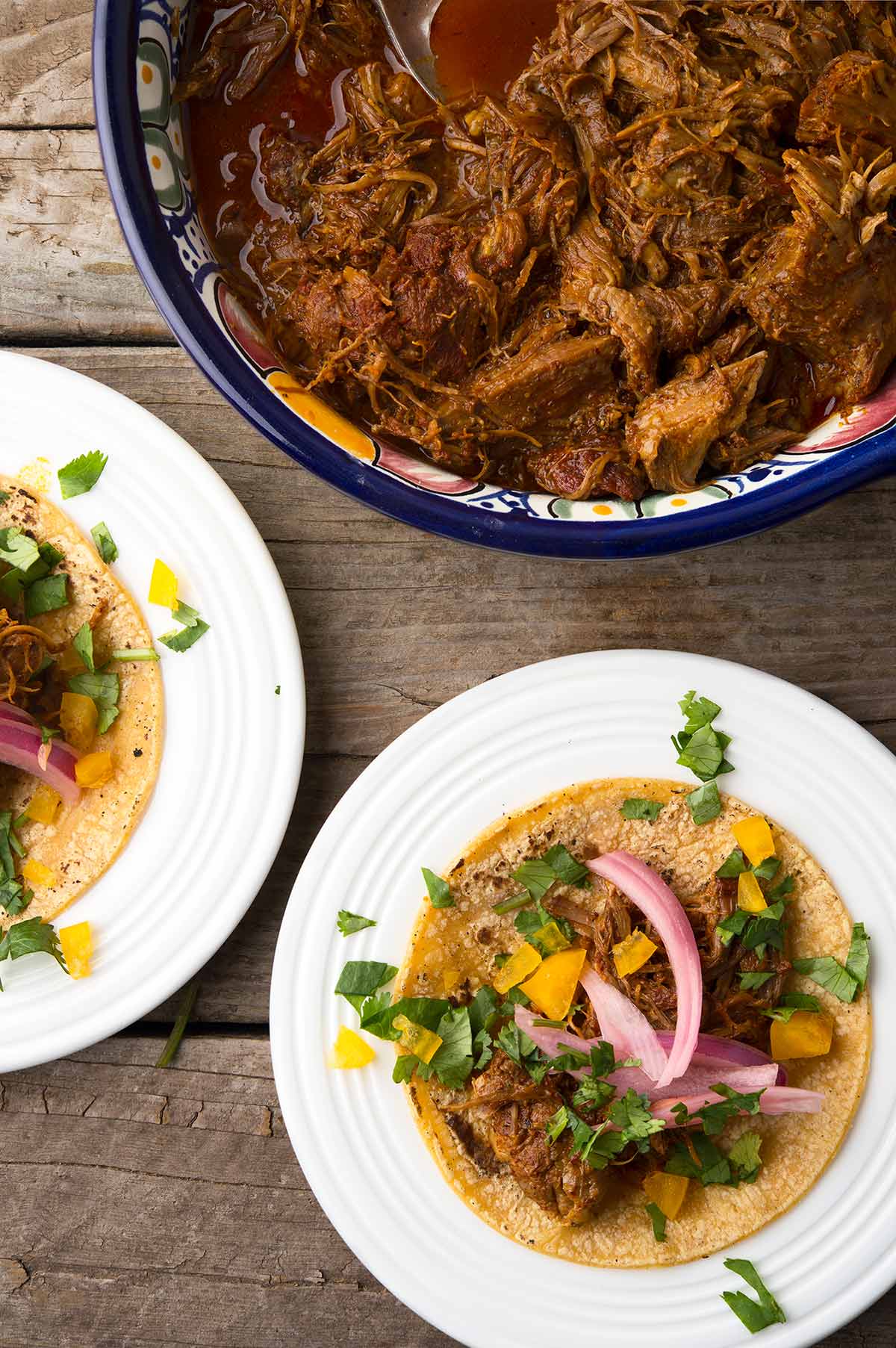
Pronounced ko-chee-nee-tah peeb-eel, cochinita pibil is also call puerco pibil when made with an older hog. Pibil refers to a pib, an earth oven — basically a pit in the yard you cook things in. Most people these days cook their pibil in a pot in the oven, though.
Holly was the first one to introduce me to this dish. She used pork shoulder and it was phenomenal. I was hooked. But the dish never shows up on the menus of really any Mexican restaurant I’ve ever been to, largely because most of the Mexican restaurants here in America are run by people from Michoacan, Jalisco, Guanajuato or Nuevo Leon.
None of these are terribly close to the Yucatan. And remember folks, Mexico is a big country. We often forget that.
My next exposure to cochinita pibil was in the movie “Once Upon a Time in Mexico,” where a CIA agent played by Johnny Depp shoots anyone who makes this dish perfectly — to maintain balance in this world. It’s an odd sidenote in a great movie, but it highlights this dish the way “Big Night” created the timpano craze.
What got me thinking about cochinita pibil lately was the amazing book Yucatán: Recipes from a Culinary Expedition by the late David Sterling. It is the best regional Mexican cookbook I’ve ever seen, and it really highlights how different Yucatecan cuisine is from that of the rest of Mexico. If you are at all interested in the cooking of the Yucatan, you need this book. My recipe below is heavily influenced by his, and my recipe for the red annatto spice mixture called recado rojo is right from his book.
The dish hinges on two ingredients that seem harder to get than they are: Achiote paste and bitter (Seville) orange juice. In a perfect world you’d use real Seville oranges and make your own recado rojo, but guess what? Most people here in America don’t. They buy pre-made achiote paste made either by El Yucateco or El Mexicano.

Surprisingly, again, given the dominance of Mexicans not from the Yucatan here in the United States, it is very easy to find in any Mexican market. And many places you can find bottles of jugo de naranja agria, which is Seville orange juice. That’s what you want. Barring that, mix regular orange juice, lime juice and grapefruit juice to get you close; the ratio is below.
It looks like it is soaked in chiles, but it isn’t. In fact, cochinita pibil is not hot at all, unless you want it to be. I do, so I mince either habanero chiles or the more delicious, less hot (but still zippy) chile manzano a.k.a rocoto chile. it’s Capsicum pubescens for those inclined to Latin.
Once you locate the achiote paste, this is a ridiculously easy dish to make with pork in all its forms, light-meat birds like chicken, turkey or pheasant, and even venison shoulder — which is actually done in Yucatan, where they hunt whitetails and brocket deer. And given the strength of spice and long cooking time, this is a great way to eat an old, trophy buck or a big ole’ boar hog.
To pickle the red onions, slice one from root to tip thinly and put the slices in a bowl. Sprinkle salt over it and then add about 1/4 to 1/2 cup freshly squeezed lime juice. Freshly squeezed matters, as the bottled stuff will impart a strange, metallic taste to the onions. Massage everything together for a few seconds, then cover the bowl and let the onions sit for at least 30 minutes, and up to a day.
To make a substitute for the Seville orange juice, use the following ratio: 2 parts orange juice, 1 part lime juice, 1 part grapefruit juice. Use yellow grapefruits if possible. And yes, fresh squeezed matters a lot here. But if you are stuck with bottled juices, it’ll be OK, just not as good.
Do yourself a favor and learn this dish using pork, chicken or whatever makes you happy. You won’t be sad.
I cook quite a lot of Yucatecan food, so if you like this recipe, you might want to try my rendition of shredded turkey Yucatan, poc chuc, which is grilled pork, dzik, which is a shredded venison salad, a stew called ajiaco, or sopa de lima.
Cochinita Pibil
Ingredients
- 1/2 cup achiote paste
- 1/4 to 1/2 cup bitter orange juice (see above)
- 2 tablespoons room temperature lard or vegetable oil
- 2 teaspoons smoked salt (see above)
- 2 to 4 pounds shoulder meat from pork, wild pig or javelina
- 1 bunch fresh epazote, chopped (optional)
- 3 avocado or bay leaves
- 1/2 cup lard
- Pickled red onions
- Minced habaneros or rocoto (chile manzano)
- Chopped cilantro
RECADO ROJO
- 1 cup annatto (achiote) seeds
- 3/4 cup white vinegar
- 1/4 cup dried Mexican oregano
- 1 teaspoon whole cumin seeds
- 1 tablespoon black peppercorns
- 12 allspice berrries
- 1 head of garlic, charred on a stovetop and peeled (see note below)
- 3/4 cup bitter orange juice (see note below)
Instructions
- If you are making your own recado rojo, the achiote paste, grind the annatto seeds in a spice grinder. The seed are hard, to you will need to grind, sift into a bowl, then grind some more. When the seeds are ground into a powder, mix them with the vinegar and set aside. Incidentally, you can get powdered annatto, but unless it's bright red, don't buy it -- the flavor gets old and stale fast. Put the oregano, cumin seeds, peppercorns and allspice into the grinder and grind that into a powder. Add it to the bowl with the achiote. Move the spice mixture, the garlic and orange juice to a food processor or blender and process until you get a thick paste. This will keep in the fridge for months.
- Get a heavy, lidded pot that will hold the meat snugly. You can either keep the meat on the bone if it will fit into the pot (javelina shoulders do), or cut it into pieces that will fit. If for some reason you are using hind legs, you will want to cut the meat across the grain into hunks about 2 to 3 inches across. If you don't do this, you will have very long strands of meat when you are ready to eat it, which isn't so nice. Mix the achiote paste with the lard, salt and enough bitter orange juice to make a sauce like a very thick BBQ sauce. Put the meat into the pot and pour the sauce over it. Massage the sauce into the meat as best you can (maybe wear gloves, as the annatto stains unless you wash your hands the second you're done), and, if you have time, Set everything into the fridge for up to a day. You don't have to do this, but a long marinade is traditional, and helpful if you cook at high-ish temperatures.
- When you are ready to cook, take the meat out of the fridge and sprinkle the epazote and avocado leaves over it. Cover the pot and put it into a 250°F oven. If you do this, the meat will take between 6 and 8 hours to cook, but will be of better texture. If you are in a bit more of a hurry, set the oven to 300°F and the meat should be ready in 3 to 4 hours.
- When the meat is ready to fall off the bone, shred it with two forks. With wild pigs or javelina, I like to add anywhere from 1/4 cup to 1/2 cup of lard to the mixture, to keep it from getting dry.
- Serve on tortillas with pickled red onions and some minced habaneros. Drizzle a little extra lime or bitter orange juice on it when you serve your tortillas.
Notes
Nutrition
Nutrition information is automatically calculated, so should only be used as an approximation.


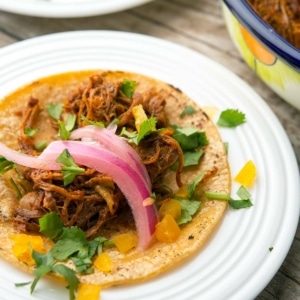
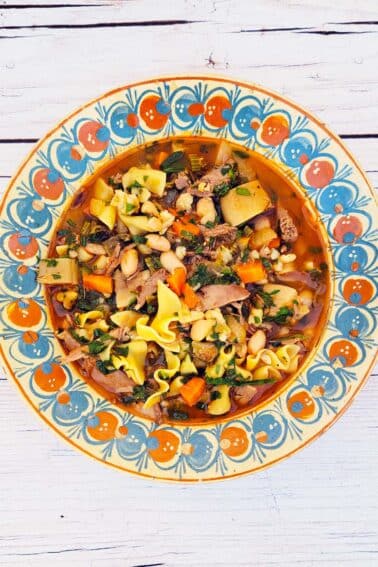

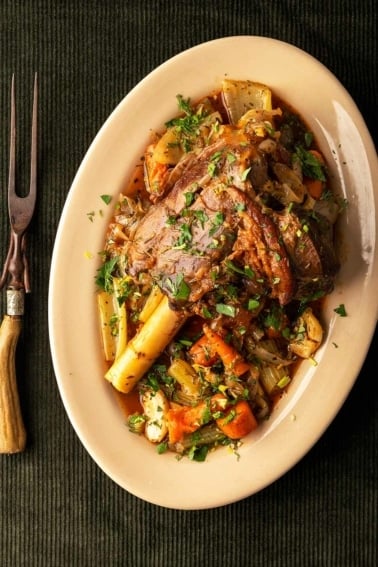
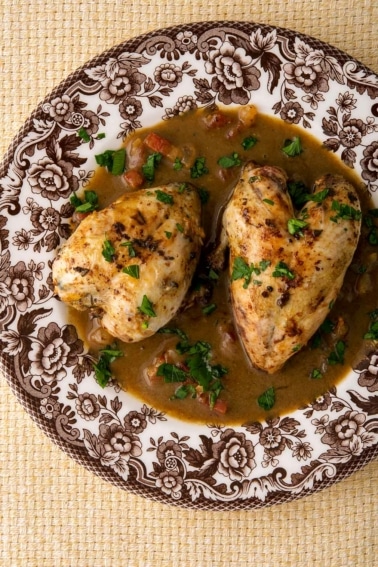
Great dish. Made this with some heritage pig but will try again with venison. Though I live in a metro area, had trouble finding the epazote and avocado leaves. Actually, I couldn’t even find achiote paste (though I have in the past). Glad you included the option to make my own. Bitter orange juice was in the spice section (?) at my Mexican market, and they had fresh banana leaves.
Honestly, this is one everyone should try. It’s incredibly easy and a very unique flavor.
Made this with an elk roast for cinco de Mayo, it turned out great. Pickled onions put it over the top! Thanks Hank, keep being awesome!
Hi Hank, I’m a bit new to cooking with boar as I finally got my first one this year. I’m trying to figure out what to do with the hams (I had the butcher leave them whole & unsmoked thinking I might be interested in doing a boar prosciutto). In the case that I find myself in over my head with the curing route, can I use this recipe or any other slow roast or braise recipe for the whole hams? Thanks again from a fellow Sacramentan!
Ryan: Sure, you could use this recipe for a whole ham. Just slow cook it until you can shred the meat.
Can this be cooked in a slow cooker?
FYI – a lot of amexican markets will have banana leaves in the freezer Section. If they are available should we simply wrap the pork before cooking?
Adriana: Yes and yes.
Thanks for clearing that up. Also, I wanted to clarify about the lard. You have it listed twice in the recipe. Once you have 2 tablespoons room temperature lard or vegetable oil and then again 1/2 cup lard. Where do you use each of these in the recipe?
Giles: The 2 tablespoons lard are for the marinade on the meat, and the 1/4 to 1/2 cup are to mix with the finished meat to make it richer tasting.
I am slightly confused on the Achiote Paste/Recado Rojo ingredient. Are you saying that you can use either the 1/2 cup store bought Achiote Paste OR make you own by combing all of the ingredients listed after/below RECADO ROJO? Thank, love the website and your books!
Giles: Exactly. Yes, recado rojo is the same thing as the store-bought achiote paste. Sorry about the confusion!
Hank, made this for the 4th and did the right hour version; big hit and no leftovers! Thanks for introducing at the South Texas hunt with Coastal Wings!
This was amazing! Made it in my slow cooker. Been following your blog for awhile but this was the first recipe I’ve tried. Some of the ingredients were a little tricky to find here in the Canadian north, but I’m glad I persevered!
Seville orange – that must be the name of the delicious bitter oranges I ate in Guatemala. So glad to finally find the name! The leaves are made into a tea with an incredible, complex flavour as well. If you can find them, I recommend it.
Do the banana leaves impart any flavor?
Jason: Yes, but it’s subtle, like the aroma you get when you cook in a clay pot.
Hi Hank,
Javelina has a distinct “skunk” flavor imparted in the animal. Does this recipe solve this unsavory side affect?
Scott: I have never smelled that on any properly prepared javelina. Sounds like whoever cleaned it got the scent gland oil on the meat.
Hank – If you are ever in Phoenix go to the Barrio Cafe they have this on their menu and it’s pretty damn good!
Mike: I don’t see why not.
Hank, any thoughts on how this might turn out if jackrabbit is used instead of javelina or pork?
Pete: Definitely worth trying, as there is a variant of this done with venison — another red meat — so jackrabbits should work, too.
While not ideal, would it be okay to just go low heat and long times in a slow cooker?
I don’t have a pit, but I do have a smoker. Would it be worth doing on there, even if I probably can’t find banana leaves?
Melissa: Try it. You will need to wrap the meat pretty tightly so it won’t leak though. I think the banana leaves are somehow permeable so they keep moisture in while adding some smoky flavor. If you want to try it, banana leaves are in the freezer section at a Mexican market.